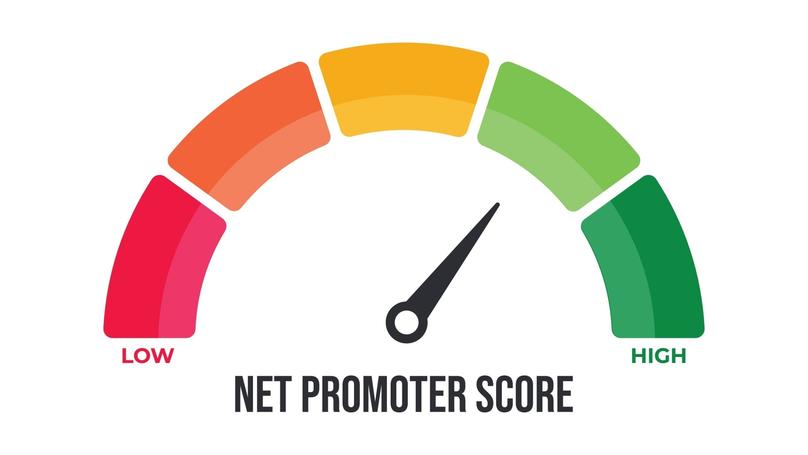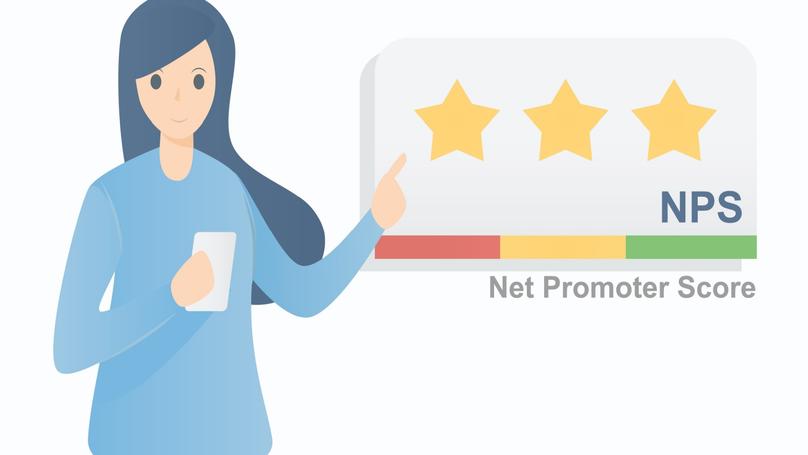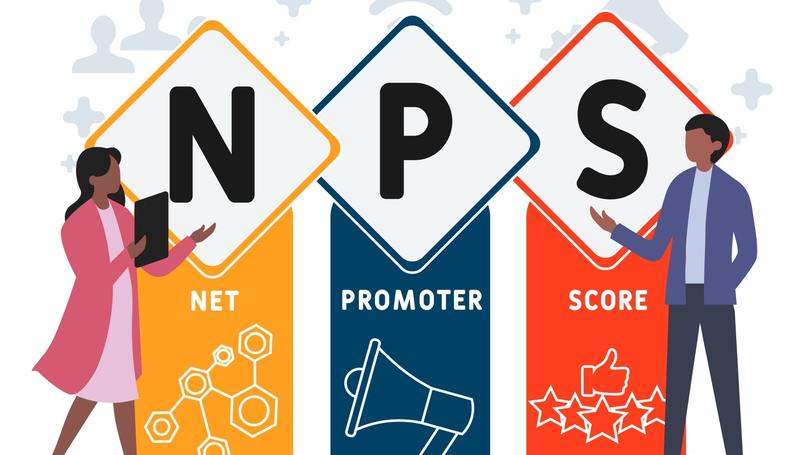Net Promoter Score (NPS)

What is NPS? (Net Promoter Score)
Net Promoter Score or NPS in marketing is a system of measurement that evaluates customer service quality based on customer loyalty. A higher NPS indicates greater loyalty and commitment to the brand, increasing the chances customers will recommend the company to their friends. NPS is evaluated by asking customers (the Net Promoter Score is based on the response), "How likely are you to recommend us to your friends?" Surveys may also assess other attributes of the brand, such as interaction quality and the effectiveness of solutions provided. Customers rate these attributes on a scale from 1 to 10, where 1 signifies "not satisfied" or "unlikely to recommend," and 10 represents "extremely satisfied" or "highly likely to recommend."
The definition of NPS was first introduced by Bain and Company in 2003. Since then, it has gained worldwide popularity as a tool to understand brand perception and reputation better. NPS surveys divide customers into three categories based on their responses: promoters (customers who give the highest scores, indicating strong loyalty and enthusiasm), neutral customers (those who are generally satisfied but not loyal enough to promote the brand actively), and detractors (customers who provide low scores, indicating dissatisfaction and a low likelihood of returning).
Engaging with all three groups is essential to improving NPS. A high NPS is a strong indicator of brand popularity and sustainable growth.
Why are Net Promoter scores important?
Understanding your Net Promoter Score (NPS) provides valuable insights into the effectiveness of your marketing campaigns, after-sales customer service, audience segmentation, and all other business efforts aimed at increasing sales and fostering long-term relationships with customers. If your NPS is consistently low and there are many detractors, it may signal issues with brand positioning, target audience identification, or direct customer communication.
The highest-ranking NPS is often seen in major international companies like Coca-Cola and McDonald's. Achieving a high NPS can position your business alongside these industry leaders. In practical terms, this metric provides a business with:
-
Reducing customer turnover: Higher customer satisfaction decreases the likelihood of customers "changing" to competitors and discontinuing the use of the brand's products or services. A high Net Promoter Score (NPS) supports customer retention and helps steady cash flows.
-
Reducing the cost of acquiring new customers: This advantage stems from the previous point and is significantly driven by recommendations from loyal customers and the power of word of mouth. Satisfied customers are likely to leave positive reviews, share their experiences on social media, and promote the brand in various ways (especially if some are influencers). As a result, word of mouth becomes a powerful marketing tool, reducing the need for more traditional, costlier methods.
-
Revenue growth: Satisfied customers use the company's services or products more frequently and gradually spend more, increasing the average transaction value. Over time, this opens opportunities to launch new product collections and raise prices, as loyal customers are often willing to pay a premium.
-
Improved CLV (Customer Lifetime Value). This metric indicates the total revenue a business can expect from a single customer throughout their relationship. A higher NPS correlates with longer customer retention, extending their lifecycle and increasing their overall value to the brand.
How to calculate NPS

How does a Net Promoter Score work in practice? As mentioned above, NPS divides customers into three categories: promoters, neutral customers (also known as passives), and detractors. The primary question in an NPS survey, around which other questions may be formed, is: "How likely are you to recommend us?" Here's a detailed look at the three groups:
-
Promoters. These are customers who rate the company 9 or 10 (on the NPS scale). They are the most enthusiastic and can be brand ambassadors and advocates online. Promoters actively enhance the company's reputation, boost recognition, and drive customer growth, mainly through referral systems, if employed in your business and provided to promoters.
-
Neutral or passive users: Those customers who rate the company's services and products with a 7 or 8 in surveys are generally satisfied but less likely to recommend the brand to friends or engage with it beyond their direct usage. The key advantage of passive users is that they can often be converted into promoters. This can be achieved by enhancing interaction and service quality in areas where these users have given lower ratings. Including additional questions in the NPS survey beyond the primary recommendation question is beneficial to identify these areas and understand why their ratings are not higher.
-
Detractors, scoring between 0 and 6 points, are the users who are least likely to recommend the company. They are unlikely to remain loyal customers or make repeat purchases. While their level of dissatisfaction can vary, their overall reaction is typically characterized by negative reviews and disinterest in the brand. Moving detractors to the promoter category is highly challenging, if not impossible. However, those who rate 5-6 points can be gradually nurtured into becoming "passive customers."
NPS formula
How is the Net Score calculated, and how does it work? It's straightforward: tally the number of users in each group based on their recommendation score. (Only the recommendation question is considered for NPS; other questions help identify weak points but are excluded from the NPS calculation.). Then, convert these figures to percentage ratios. For instance, 10% of respondents fall into the "detractors" category, 20% are passive clients, and 70% are promoters.
The NPS formula will enable you to calculate the value of this indicator, and it looks like this:
% Promoters - % Detractors = NPS
Example: 70% - 10% = 60 NPS.
You can also find numerous online NPS calculators available on the Internet. Additionally, by integrating Net Promoter Score software designed for analyzing and measuring NPS, you can automatically generate the assessments.
What constitutes a good NPS?

NPS ranges from -100 to 100. This means it can be both positive and negative. A negative score indicates that the company has more detractors than promoters, which is perilous. It can seriously damage the brand's reputation, leading to a decline in sales, a potential crisis, and even business closure.
The ideal NPS varies by industry. According to a study by the American company Temkin Group, for Internet service providers, a good score is 0, reflecting a balance between promoters and detractors. For car dealerships, it should reach at least 39, while online stores need an even higher score, between 60-65 NPS. The Qualtrics XM Institute reports that in the food industry, the average NPS is 30, and in the streaming video industry, it's 29. The score is also influenced by the business's location and the target audience's age, as different age groups perceive "recommendations" differently.
Bain & Company, the pioneers of the NPS concept, have developed the following system for categorizing ratings as "bad" or "good":
-
Above 0 - good.
-
From 20 to 50 - favorable and indicates good development prospects.
-
From 50 to 80 - high performance.
-
Above 80 - a world-class business: This rating is typically achieved only by the largest companies.
Achieving an NPS rating of 100 is virtually impossible and should not be the ultimate goal for companies. It is crucial to monitor the ratio of promoters to passive customers and consistently work on improving their satisfaction levels. Simultaneously, efforts should be made to engage with detractors to prevent their numbers from rising. Suppose there is a sudden and dramatic shift in any of these groups. In that case, it's essential to investigate which events or advertising campaigns may have influenced this change, whether positively or negatively.
How to use NPS
NPS is a powerful self-improvement tool for businesses, enabling them to examine various aspects of their operations simultaneously, such as the number and quality of customer touchpoints, the effectiveness of communication channels, and pre-sales and post-sales support. Each NPS study should be compared with previous results. It is recommended to measure NPS every 3-6 months and 2-3 months after any significant campaigns to boost it.
Recognizing that NPS merely indicates the business's problems, not the root cause, is crucial. Therefore, enhancing the NPS rating with other customer data gathered through multiple channels is essential to avoid biases and distortions from relying on a single source. Additionally, NPS should be evaluated in the context of prior corrections or changes. If customers consistently report the same issue, this suggests a persistent problem or disruption that is causing this issue, such as a missing vital instruction in the product guide, etc.
Abandoned carts may point to UX issues, and excessive forced interactions with a manager or consultant might degrade customer service quality instead of enhancing it. In essence, NPS serves as evidence, highlighting a trail of problems. However, this trial requires further investigation, and NPS alone won't suffice. The more data you gather alongside NPS, the better you'll be able to improve its measurement system.
How to enhance your NPS

There are numerous ways to boost your NPS. Generally, any improvement in business areas that impact customers or relationships with them will naturally enhance your NPS. However, there are more specific steps you can take to achieve this.
Identify areas for business improvement
As mentioned, NPS signals whether something is amiss or thriving in various areas of your business. To effectively track it, you need a thorough analysis over time, identifying patterns, recurring themes, and intersecting regions. Compare your NPS with industry benchmarks and successful competitors to gauge your position in the market. Additionally, assess not only the top performers but also those lagging behind. Understand their shortcomings and determine what you must avoid to improve things.
Tip: Ensure you craft the primary Net Promoter Score question accurately. If your survey includes additional evaluations, maintain one question in its traditional, straightforward form: "Would you recommend our company to your friends?"-without any subtext or embellishments.
Address negative reviews
Engaging with detractors is crucial for reducing customer turnover and mitigating negative opinions and their potential repercussions. You certainly don't want anyone spreading negative feelings about your brand across forums or social media. Likewise, interacting with detractors helps you identify weak points in your business and understand what went wrong. Please don't ignore them or pretend they don't exist. Try the following approach:
-
Establish corporate social networks if they are not already in place.
-
Respond to negative reviews across all platforms and invite the reviewer to email you to clarify and resolve the situation.
-
Keep an eye on new reviews on regional and international websites dedicated to evaluating places and brands (e.g., Google Maps), and follow the steps mentioned above.
-
Create an email or dedicated section to address complaints or negative reviews directly. This approach can help prevent the rise of new detractors by allowing you to address their dissatisfaction and resolve the problem.
Segment your customers and personalize your content
Your target audience comprises the most likely and general audience of your brand. Still, within this group, distinct segments can be categorized by demographic data (location, age, education, etc.) and consumer habits (frequently viewed product categories, purchase patterns, frequency, etc.). Personalization makes customers feel your business "knows them by sight" and values everyone it engages with. Employ personalization through the following methods:
-
Gather data on each customer and enter it into a dedicated database. Use this information to categorize customers into 3-4 general groups. Key data points include activity on the brand's website or social media, purchase history, past feedback experiences, and demographic indicators (what interests a teenager is unlikely to captivate someone over 50, right?). Over time, you can further segment these groups into narrower categories, enhancing personalization.
-
Configure recommendations so that customers receive offers tailored to their particular segment.
-
Create content tailored to each segment, such as buy-one-get-one-free discounts for students, exclusive offers for loyal customers and social media followers, guides on creative uses of buttons for recent buyers, etc.
Encourage more feedback
For NPS scoring results to be reliable, you need a large and diverse sample, like any opinion research. Simply placing a "Would you recommend us?" question on the website after a purchase isn't enough-expand and diversify your feedback channels. For instance, send a survey link to customers via email a week after they purchase your product and remind them to complete it through SMS or mobile app notifications.
Encourage customers to participate in surveys and, more importantly, leave reviews- for example, by offering a "10% discount for a review!" promotion. The more channels and tools you have for collecting feedback, the more reliable and detailed your understanding of customer opinions will be. Additionally, this approach helps measure NPS more accurately by covering the entire target audience, which may prefer different communication channels, thereby ensuring broader engagement.
Tip: Position NPS surveys at pivotal moments of customer interaction with your business, such as after purchase, following support service communication, or 10 days after product usage. A customer's NPS can fluctuate at different stages of their journey with your company and across various areas of interaction.
Adopt a customer-focused culture
Adopt an environment where employees prioritize customer satisfaction and effective problem-solving. Implement a comprehensive training system, grant employees access to skill development resources and a customer database, and give them some autonomy to make decisions about customer issues and offer solutions. This helps eliminate the frustrating "We'll transfer you to another department; please hold" scenario.
Enhance the quality of customer service
Employ CRM systems and caller IDs that display all customer data on the manager's computer. Assign a "personal manager" to each user, ensuring they have a particular expert to contact. Offer multiple communication channels with the support service, from instant messengers to phone calls. Provide individual offers at the end of interactions to address problems and misunderstandings. All these steps significantly enhance customer service, boost satisfaction, and foster an emotional connection with customers. Additionally, it is crucial to develop managers' active listening and emotional intelligence skills for more effective and comfortable communication with customers. The training system mentioned previously will support this development.
Tip: Provide customers with self-service options to streamline support and boost satisfaction. For instance, it could offer access to a product knowledge base, flexible personal account settings, guides, the option to decline a manager's call after placing an order and automatically confirm it, or even a self-service checkout in offline stores.
Utilise Live Chat
Live chat is a powerful customer service tool that significantly boosts NPS, warranting its dedicated section. This software enables continuous real-time user interaction and can be integrated into an online store or blog. It allows customers to quickly reach a manager with just a few clicks, fostering a responsive, flexible, and convenient support ecosystem. Additionally, you can deploy a bot to handle common questions like "How should I address you?" or "How does it work?" autonomously, thereby reducing the workload on live operators.
Tip: Integrate the online chat with the customer database so the bot or manager can immediately address the person by name and access their customer data. This enables you to provide a ready-made solution even faster.
Conclusion
The Net Promoter Score calculation is an indispensable tool for making strategic decisions. It acts as a compass, helping you navigate data, connect different elements, and improve business operations at all levels. However, NPS should not be viewed as a standalone tool but as part of a broader framework for implementing changes, allocating resources, and developing new products. While most companies use NPS surveys to gather customer feedback, they can also be used to gauge employee opinions. How likely are they to recommend your company as a place to work? If the likelihood is low, investigate the reasons-working conditions, low pay, or other factors. Use NPS to monitor the "inner health" of your brand! This approach is a universal starting point for any research and transformation, particularly if you're uncertain where to begin.























